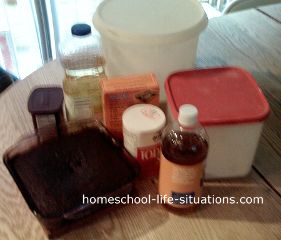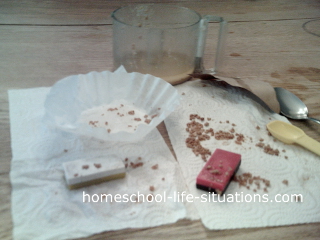Food Science Experiments
for Fun and Learning
I love teaching in the kitchen. Today we are going to do some food science experiments. Your child will be rewarded with an edible goody or seeing food used in an unusual way.
Scientific Method
Food science experiments can be fun, but our children need to learn to think scientifically. We can teach our children to make observations. Older children can make hypothesis to explain the observations.
Make Something Edible
My children like to make things to eat in the kitchen. With a little thought you can also teach them about science.
Food science experiments can teach your child about how temperature can change matter. You can have your child watch water turn into ice or you can make it an edible project by making popsicles
Popsicles
You will need three paper cups and either popsicle sticks or spoons. Fill one cup half full with water. Place orange juice in the second cup. Use pudding in the third cup. Have your child check the cups every half an hour to see which cup froze first.
Making a Cake
Baking can also teach your child how temperature can change matter. Your child will learn about how ingredients interact with each other to make edible food.
Here is a list of the main ingredients used in baking and a simple explanation of what it does;
- Flour -- is for structure
- Sugar -- causes the product to brown
- -- is for flavor
- -- combines with fat to make air pockets
- Fats -- coats the gluten so they don't easily combine
- -- helps make the product tender
- -- helps with flavor
- Eggs -- leavening
- -- emulsifier
- -- also help in making cakes light and tender
- Leavening agents -- such as baking soda or yeast -- form carbon dioxide that causes the product to rise
- Liquid -- forms the gluten bonds
- -- makes the product light and tender
- -- creates steam which helps in leavening
- -- helps with the flavor
A basic cake combines flour, sugar, eggs, and oil. A balance of the three ingredients is needed to make a cake. Fewer eggs make a denser cake. More flour makes a bread like cake.
Wacky Cake
Wacky cake does not use eggs for leavening or binding. A chemical reaction causes the cake to rise. It is a most tender cake. My recipe calls for;
- 1 1/2 cup flour,
- 1 cup sugar, 4 tablespoons cocoa,
- 1 teaspoon baking soda,
- 1/2 teaspoon salt,
- 1 teaspoon vanilla,
- 1 tablespoon vinegar,
- 6 tablespoons oil,
- 1 cup water.

Other Cool Things to Do with Food
There are other food science experiments. You do not need to make something edible.
My son learned about density by combining water, oil, and maple syrup. The mixture settled into three layers with the oil on top, then the water, and last the syrup. He also dropped in a grape and a ice cube. The ice floated on the water. The grape floated on the syrup layer.
You can also test your breakfast cereal to see how much iron is in it. You will need a strong magnet and a cereal fortified with iron. Most experiments recommend Total. I used Grapenuts. I used a food processor to crush the cereal. I then placed some water in the bowl. I then held a bar magnet in the bowl of cereal and water. Some of the cereal stuck to the magnet. I was not sure of what I was looking at so I place a metal spoon, a plastic spoon, and a piece of cardboard in the bowl. The Grapenuts did not stick to the spoons or cardboard. I also crushed the cereal to a fine powder and placed it on a plate. Some of the powder stuck to the magnet.

A potato can be used to determine the polarity of a battery. Cut the potato in half. Connect some copper wire to each terminal on the battery. Place the wire about one inch apart on the potato. Make sure that the wires do not touch. Soon one of the wires should turn green. The other wire may bubble. The bubbles indicate the positive terminal and the green indicate the negative terminal. I noticed a green spot on the potato under the wire that was hooked to the negative terminal. The other wire did not bubble.
I have also heard that lemons can produce electricity. I wonder if there are other fruits or vegetables that can do the same.
Food science experiments can teach your child about the world in which he lives.






New! Comments
Leave me a comment in the box below.